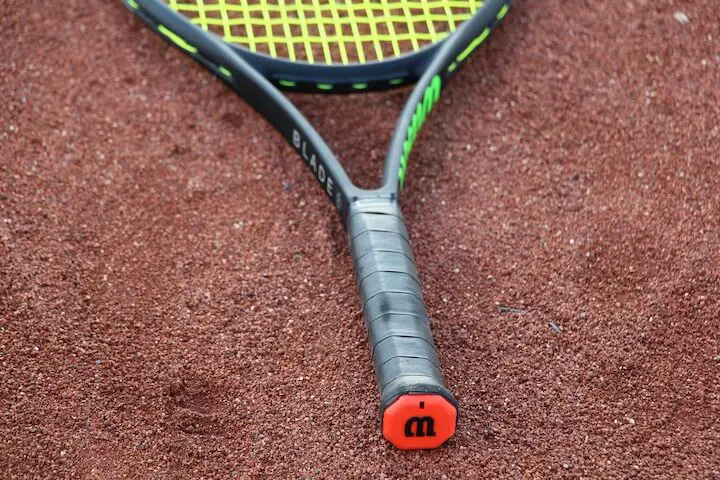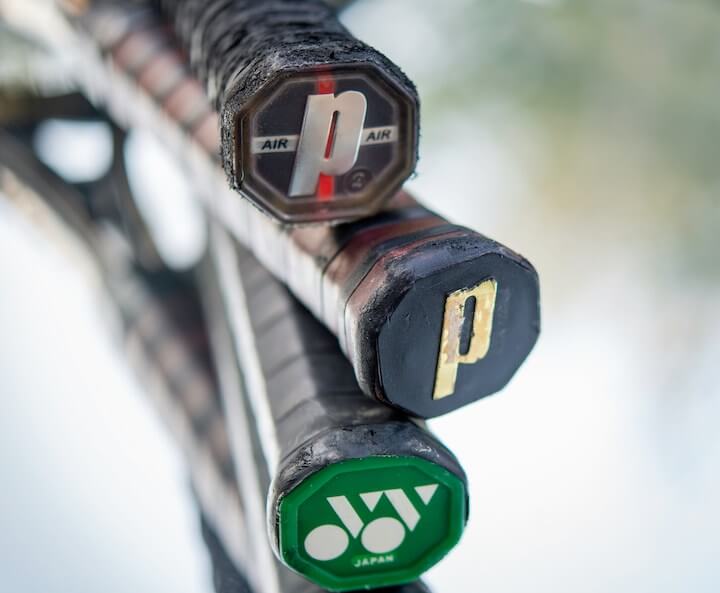
We're an affiliate
We hope you love the products we recommend! Just so you know, we may collect a share of sales or other compensation from the links on this page. Thank you if you use our links, we really appreciate it!
Have you ever picked up your racket mid-match and felt it slipping in your hand? I have, and it’s not fun. The first time it happened to me, I remember missing an easy forehand because my grip twisted at the worst possible moment. That was the day I decided to learn how to regrip a tennis racket properly.
You might think it sounds complicated, but trust me—it’s not. Once you understand the steps, it becomes second nature. Regripping doesn’t just keep your racket looking neat. It improves comfort, gives you better control, and even helps prevent blisters or wrist strain. If you’ve never done it before, don’t worry. By the end of this guide, you’ll know exactly how to regrip a tennis racket on your own without fuss.
Table of Contents
Key Takeaways
- Regripping isn’t complicated—it just takes a bit of patience the first few times.
- A clean, tight grip improves comfort and gives you better control on the court.
- Regular maintenance keeps your hands happy and your shots more consistent.
- Once you learn how to regrip a tennis racket, you’ll never have to pay someone else to do it again.
Understanding the Two Types of Grips
Before you start, it’s good to know the difference between replacement grips and overgrips. I remember the first time I walked into a tennis store. I stood staring at the wall of grips, confused. Some were thick. Others were thin. Some even had perforations. I had no idea which one I needed.
Think of it like this:
Replacement grips are your foundation. They go directly on the bare handle. If your original grip is worn out, peeling, or hard, this is what you replace.
Overgrips, on the other hand, are like that extra layer of comfort. You wrap them on top of the existing grip. They’re great if you want more tackiness or if your hands sweat a lot during play.
I use overgrips more often because I sweat quite a bit. But every few months, I’ll do a full replacement to keep things fresh. Knowing when to use each type helps make your regripping smoother.

What You’ll Need Before You Start
Before we jump into how to regrip a tennis racket, make sure you have the right tools ready. It’s like cooking—you don’t want to start and then realize halfway you’re missing the scissors.
Here’s what you’ll need:
- A new replacement grip or overgrip (depending on what you’re doing)
- Scissors to trim the end neatly
- Finishing tape (usually included with the grip)
- A clean towel to wipe off any residue on the handle
I usually lay everything out on a table so I don’t fumble around later. Also, if the old grip left sticky residue, a quick wipe with a damp cloth helps keep the new grip smooth.
Also Read: Wrist Snap vs Racquet Lag: The Real Secret Behind Effortless Power
Step-by-Step: How to Regrip a Tennis Racket
Alright, this is where the magic happens. Learning how to regrip a tennis racket isn’t about speed at first—it’s about getting it clean and even. Take your time. Once you do it a few times, you’ll fly through these steps like it’s second nature.
Step 1: Remove the Old Grip
Start by gently peeling off the old grip. You’ll usually find a small piece of finishing tape at the top—remove that first. As you unwrap, check the handle underneath. If there’s any leftover adhesive or rough patches, wipe it clean. I once skipped this step in a rush, and the new grip ended up bumpy. Lesson learned.
Step 2: Start at the Butt Cap
Grab your new grip and look for the tapered end. That’s the part you’ll place at the butt cap (the base of the handle). This is your anchor. Secure it tightly so it doesn’t shift as you wrap. Some grips come with a little sticky strip at the start—if yours does, peel it off and press it down firmly.
I remember the first time I tried this, my grip slipped because I didn’t anchor it well. It unraveled mid-wrap. So don’t rush this part.
Step 3: Wrap Diagonally Upwards
As you start wrapping, go diagonally upward around the handle. Keep even tension the whole way. You don’t want it too loose, or it’ll bunch up. You also don’t want it so tight that it stretches and tears. Overlap each turn slightly—just enough to cover the edge of the previous layer.
This step affects how your hand feels during play. A neat, even wrap means your fingers sit comfortably without weird ridges.
Step 4: Adjust as You Go
Don’t be afraid to pause and adjust. I often stop every few wraps to smooth out the grip with my thumb. If you see wrinkles or uneven overlaps, unwind a little and fix it. It’s better to get it right than to live with a lumpy handle for weeks.
Think of it like painting a wall. You don’t rush through and leave streaks—you smooth it out as you go.
Step 5: Cut and Tape
When you get near the top of the handle, grab your scissors. Trim the excess grip at an angle so it fits neatly. Then use the finishing tape to secure the end. Some grips include branded tape, but if yours doesn’t, electrical tape works fine too.
Once you’re done, run your hand over the grip. It should feel smooth, snug, and even all the way up.
Pro Tips for a Better Grip
Over time, I’ve picked up a few tricks that make regripping easier and cleaner. These small details make a difference when you’re learning how to regrip a tennis racket well.
Keep the wrap tight but not too tight. A little tension helps the grip stick smoothly, but pulling too hard can stretch or tear it.
Practice makes it neater. My first few attempts looked a little wonky. After a few months, I could regrip in under five minutes and it looked like it came from a pro shop.
If your hands sweat, use overgrips and change them regularly. Some players change overgrips every week, especially in humid weather.
Know when to replace. If your grip feels slick, hard, or starts peeling, that’s your cue.
I usually keep a few spare overgrips in my bag. On hot days, I’ll swap one out between sets. It’s a small thing that makes a big difference in control.

Check Out:What Is The Difference Between Tennis Shoes And Racquetball Shoes?
Common Mistakes to Avoid When Regripping
I’ve made every mistake you can think of when learning how to regrip a tennis racket. Here are the big ones to avoid:
- Wrapping too loosely: This makes the grip slide around and causes blisters.
- Overlapping too much or too little: Too much overlap creates bumps; too little leaves gaps.
- Starting at the wrong end: Always begin at the butt cap, not the top.
- Using the wrong type of grip: If your base grip is falling apart, an overgrip alone won’t fix it.
The first few times, I unwrapped and rewrapped my racket multiple times. It’s part of the process. Don’t get frustrated if it’s not perfect right away.
How to choose the right grip for your hand and playstyle
Choosing the right grip can change how the racket feels in your hand. I used to pick grips by color—fun, but not smart. Over time I learned to think about thickness, tackiness, and how the grip fits my palm. If you have smaller hands, a thinner replacement grip or a single overgrip often works better. If you like a cushioned feel, choose a thicker replacement grip or stack an overgrip on top.
Think about what you want: control, comfort, or shock absorption. Control tends to favor firmer, thinner grips. Comfort and shock absorption favor thicker or cushioned ones. Also, consider the climate. If you play in humid weather, breathable grips with perforations help. If you sweat a lot, tackier overgrips will save you from slipping mid-rally.
One quick trick: try wrapping an overgrip at home for a few sessions before committing to a replacement. If you like it, then do a full replacement. That way you test how a grip affects your serve toss and your topspin without a full commitment. I do this often when trying new grips—keeps things simple and saves money.

Conclusion
When I first learned how to regrip a tennis racket, I thought I’d mess it up. I did, a few times. But then it clicked. Now, it’s something I actually enjoy doing—it’s a small ritual before a big match.
If your current grip is slick or peeling, grab a new one and give it a try. Take your time, follow the steps, and don’t worry if it’s not perfect on your first go. Your hands will thank you the next time you step onto the court.
Frequently Asked Questions
How often should I regrip my racket?
It depends on how often you play. I play three to four times a week, so I change my overgrip every 1–2 weeks and my replacement grip every 2–3 months. If you feel slipping or see peeling, it’s time.
Can I use an overgrip without removing the old one?
Yes, you can. That’s actually the point of an overgrip. You wrap it on top of your existing grip to add tackiness or cushioning without replacing the base layer.
How long does it take to regrip a racket?
Once you get the hang of it, about five minutes. The first time might take 10–15 minutes if you’re adjusting a lot, but that’s normal.
Do I need special tools to do this?
Not really. A pair of scissors and the tape that comes with the grip are enough. Some people use a staple gun at the butt cap for extra security, but it’s optional.




